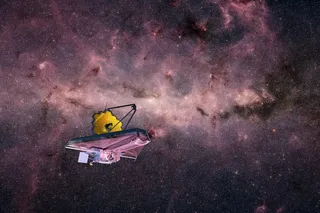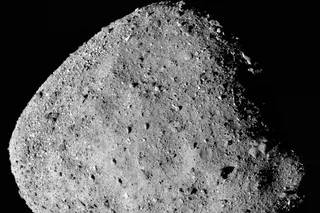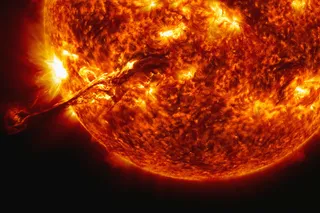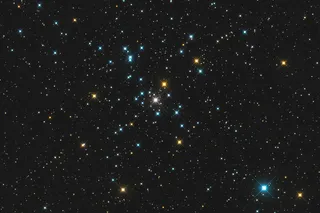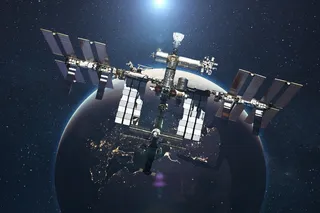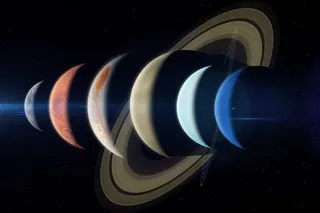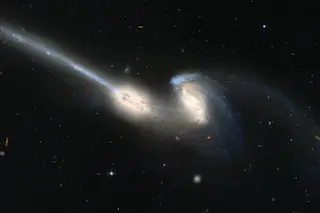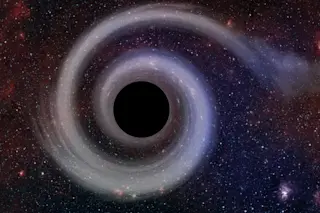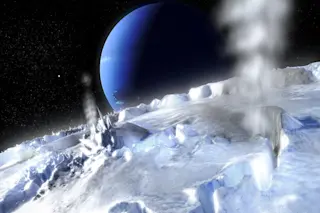When Neil Armstrong took “one giant leap for mankind” onto the surface of the moon in 1969, his booted foot sank into a layer of fine gray dust, leaving an imprint that would become the subject of one of the most famous photographs in history. Scientists called the dust lunar regolith, from the Greek rhegos for “blanket” and lithos for“stone.” Back then scientists regarded the regolith as simply part of the landscape, little more than the backdrop for the planting of the American flag.
No more. Lunar scientists have learned a lot about the moon since then. They’ve found that one of the biggest challenges to lunar settlement—as vexing as new rocketry or radiation—is how to live with regolith that covers virtually the entire lunar surface from a depth of7 feet to perhaps 100 feet or more. It includes everything from huge boulders to particles only a few nanometers in diameter, but most of it is a puree created by uncountable high-speed micrometeorites that have been crashing into the moon unimpeded by atmosphere for more than 3billion years. A handful of regolith consists of bits of stone,minerals, particles of glass created by the heat from the tiny impacts,and accretions of glass, minerals, and stone welded together.
Eons of melting, cooling, and agglomerating have transformed the glass particles in the regolith into a jagged-edged, abrasive powder that clings to anything it touches and packs together so densely that it becomes extremely hard to work on at any depth below four inches.
For those who would explore the moon—whether to train for exploring Mars, to mine resources, or to install high-precision observatories—regolith is a potentially crippling liability, an all-pervasive, pernicious threat to machinery and human tissue. After just three days of moonwalks, regolith threatened to grind the joints of the Apollo astronauts’ space suits to a halt, the same way rust crippled Dorothy’s Tin Man. Special sample cases built to hold the Apollo moon rocks lost their vacuum seals because of rims corrupted by dust. For a permanent lunar base, such mechanical failures could spell disaster.
Regolith can play havoc with hydraulics, freeze on-off switches, and turn ball bearings into Grape Nuts. When moon dust is disturbed, small particles float about, land, and glue themselves to everything.Regolith does not brush off easily, and breathing it can cause pulmonary fibrosis, the lunar equivalent of black lung. There is nothing like it on Earth. “Here you have geological processes that tend to sort and separate,” says geologist Douglas Rickman of NASA’s Marshall Space Flight Center. “On the moon you have meteorite impacts that mix everything together.”
But space planners also see a brighter side to the story. Forty-two percent of regolith is oxygen by weight. Extract that and it will help make breathable air, rocket fuel, and, when mixed with hydrogen, water.Heat up regolith and it will harden into pavement, bricks, ceramic, or even solar panels to provide electricity. Cloak a living area in a thick enough blanket of it and it will enable astronauts to live radiation-free. If regolith is the curse of lunar exploration, it may also prove to be a blessing.
These issues lay dormant for three decades until January 2004, when President Bush announced his “Vision for Space Exploration” and gave NASA a new mandate: Return humans to the moon by 2020 and eventually send them on to Mars. More details of this plan emerged last December at a meeting of the American Institute of Aeronautics and Astronautics in Houston. Scientists are now thinking about what is needed to make the vision a reality. While there is debate about the political will to sustain lunar exploration (see “The Future of NASA,” DISCOVER,September 2006), the technical hurdles are beyond dispute. The next person to step on the moon again will be taking humanity where it has never gone before, because that person will be settling in to stay—and that will be extremely hard to do.
NASA’s current plans call for a series of “precursor” robotic lunar missions to test technologies and gather information. These will begin next year, long before NASA’s new Orion spaceship is ready to loft its four-astronaut crew moonward. By the time that happens, perhaps around 2018, planners hope to have resolved some key unknowns: whether there are ice deposits at one of the lunar poles, whether a space suit can be made that can survive multiple journeys across the dust-ridden landscape, and whether the human body can survive dust, lengthy stays in reduced gravity, and prolonged exposure to cosmic radiation.
+++
A sunlit crescent of Earth seen from the moon.
The first trips will be Apollo-like sorties, brief visits to test techniques and equipment and to begin building the outpost. Eventually the base will include living quarters, a launchpad, a storage facility for fuel and supplies, and a power plant. By 2024, NASA experts expect to have enough infrastructure to support a permanent human presence with four astronauts rotating every six months, the same length of a stay as on the International Space Station.
Setting up a permanent outpost on the moon would, in many respects,be more daunting than putting an outpost on Mars. Like Earth, Mars has an atmosphere, weather, and seasons, and its gravity is one-third of Earth’s. The moon has one-sixth of Earth’s gravity, no atmosphere, and a merciless and unending barrage of radiation and micrometeorites. Some scientists argue that if going to Mars is the ultimate goal, there’s no point in going to the moon.
But if the goal is learning about long-term stays in space, going to the moon provides excellent instruction. Space station astronauts are in low Earth orbit, only 224 miles from safety. Moon astronauts will be three days from help, and Mars astronauts will, at best, be months away—virtually alone after liftoff. The explorers will not only have to learn to live in reduced gravity in cramped spaces for prolonged periods, as in the carefully calibrated indoor environment of the space station, but they must also work outside for extended periods in potentially lethal environments they cannot control. They must make consumables like oxygen, recycle them, and recycle waste. They must be able to maintain their equipment, knowing that not only their scientific mission but their very lives may depend on their repairs.And they must be able to cope with sickness, set broken bones, perform emergency appendectomies, and, in the worst of circumstances, watch a comrade die from injury or blood loss, knowing that he or she could easily have survived with timely treatment at a terrestrial hospital.
Coping with these challenges will require an attitude adjustment and a lot of practice, and screwups are better handled closer to home.Former astronaut and U.S. senator Harrison Schmitt, the last man to walk on the moon, told delegates at a NASA-sponsored moon conference last year that humanity needed to “redevelop a deep space operational structure and discipline.” Others describe the situation more bluntly.NASA, grown skittish because of the losses of space shuttles Challenger and Columbia, has become too risk-averse.
“There are things we have to decide,” says University of Tennessee geochemist Lawrence Taylor, a leading moon scientist. “There’s going to be a hazard, and if we think it’s dangerous to go to the moon, what about Mars? You just can’t bail out and go home.”
The abrasive regolith is just one aspect of the moon’s harsh environment. The equator promises relatively happy landings on relatively smooth surfaces, but it also guarantees temperatures that exceed 250 degrees Fahrenheit during the day and plummet below –240°F during the night—and both day and night last 14 Earth days. The Apollo astronauts did most of what they did during the lunar equivalent of early morning and forenoon—light enough to see but not as hot.
Climate is the main reason NASA announced last December that it would build its outpost near one of the lunar poles. The current favorite spot is the edge of Shackleton Crater at the moon’s south pole, which is expected to feature “moderate” temperatures, between–50 degrees F and 50 degrees F. Shackleton also has the important advantage of being in sunlight—albeit weak sunlight—for up to 80 percent of the year.Abundant light will be crucial for generating electricity. If the base were built at the lunar equator, it would be in darkness for half of every month. During that time, solar-collecting arrays would be useless.
Another important attraction of the moon’s poles is the possible presence of useful natural resources. Lunar orbiters in the 1990sdetected concentrations of hydrogen, a potential resource for rocket fuel. Currently no one knows how much there is or what form it takes.Some scientists suspect that a comet may have sideswiped the moon long ago, leaving water ice buried in permanently shadowed craters.Identifying the source of the hydrogen is a key goal for the robotic missions that will precede the next landing by humans. The downside of a polar landing is that the landscape there is craggier and more forbidding than at the moon’s midline, which makes landings more challenging. Nonetheless, NASA officials believe the advantages at the south pole outweigh the risks.
+++
No matter where the base is sited, astronauts on a prolonged lunar mission must contend with low gravity and radiation. Although the muscle- and bone-weakening effects of low gravity won’t be a problem during the brief initial moon missions, shielding astronauts from damaging radiation exposure will be an immediate concern.
One idea is to wrap the lunar habitat in an envelope filled with radiation-absorbing water. Another is to rig an artificial magnetic field to deflect the worst rays. The easiest solution, however, will probably be to put the regolith to work: Simply place the habitat modules in a crater and bury them under a thick layer of moon dust.
How much regolith is necessary? Nobody knows. It is conceivable that radiation will cause chain reactions below the surface of the lunar soil, producing fission products from secondary reactions that are even more harmful to human tissue than unshielded bombardment. Taylor suspects that it would take 10 feet of soil or more to insulate the astronauts.
So astronauts will have to dig into the regolith, and this will not be as easy as it sounds. First there is the challenge of getting heavy equipment into space. “We can’t afford to send a 200,000-poundbulldozer to the moon,” says Middle Tennessee State University civil engineer Walter Wesley Boles, a longtime student of lunar construction.“And even if we did, it would perform very poorly.” Engineers will have to think small. A lunar regolith mover will be “about the size of a riding lawn mower,” Boles says. NASA is holding a regolith-digging contest this May, offering a $250,000 prize to the team whose robot digs the most regolith in 30 minutes—but the excavator must weigh less than 90 pounds.
Then there are even more fundamental physics problems. Heavy machinery on Earth depends on friction and gravity to provide a stable underpinning while the machine’s business end cuts, pushes, pulls,digs, scrapes, or pounds. On the moon, inertia is the same—nudge something and it will move with the same vector it has on Earth—but gravity is different. Jab too hard and the machine will jump. Twist too hard and the machine tips over.
One solution is to build a bin on the back of the bulldozer and fill it with regolith to make a counterweight before serious digging begins.Another is to outfit the bulldozer with augers, so it can screw itself into the lunar surface. Boles suggests getting rid of the blade altogether and mounting a brush or a construction sweeper that would use less force and skim the regolith one thin layer at a time.
As they excavate the moon, astronauts can count on being enveloped in clouds of dust, especially if they use a sweeper. The effects of man-made regolith dust storms on tools and equipment have been known since the backwash from Apollo 12’s engines sandblasted the derelict old Surveyor 3 spacecraft lying nearby. “They found moondust in every nook and cranny,” says William Larson of the Kennedy Space Center, a lead scientist and program manager in NASA’s efforts to develop techniques for using lunar resources. Every artist’s rendering of an imagined lunar outpost features regolith mounds that would screen vital equipment and habitat from rocket-induced dust clouds on the launchpad.
Moondust is also a major unresolved issue for NASA’s next-generation space suit. During the Apollo missions, three days of abbreviated moonwalks was about the limit before zippers balked, joints stiffened, and connectors began to clog. The new astronaut explorers must have a solution that will enable them to work there. Johnson Space Center space suit engineer Amy Ross says: “We’re going to have to maintain ball bearings [in the joints] and replace seals. We can’t have zero tolerance, but we don’t want to suck up all the astronauts’ free time doing maintenance.”
Space engineers are still debating whether to have astronauts don overalls for dirty work or to build a “dust porch” where astronauts can clean up before entering their living quarters. They are also grappling with how to make a suit that will not easily cut or abrade yet will weigh no more than 200 pounds on Earth—33 pounds on the moon. “It’s fairly challenging,” Ross acknowledges.
+++
Despite all its hazards, regolith may hold the answer, not just for blocking out radiation but also for providing building material for a self-sustaining outpost on the moon. The key lies in particles of glass and metallic iron in the lunar soil. In the 1990s the University of Tennessee’s Lawrence Taylor showed that finer samples of regolith contain enough of this material to make it useful. “One night I go downstairs and stick some of it [the regolith] in the microwave,” he recalls. “I had no reason to do it. It had been tried years ago and never worked. This time it just went zap! ”
Taylor found he could melt a pile of lunar soil in 10 to 20 seconds.Then he focused a single magnetron on another sample: “With 50 watts of energy I took a one-centimeter block of lunar soil to 1700 degrees Celsius (3100 degrees F) in 10 seconds,” he says.
This result has tremendous implications. By microwaving lunar soil, astronauts could weld, or sinter, the particles together to form a serviceable foundation. If they raise the temperature, the top layers would melt and turn into a tough glass. Not only would the explorers have an instant highway, they would also mitigate the worst of the dust clouds. Regolith does not blow around by itself on the moon. Human feet or tire treads have to stir it up, and if they are traveling on pavement, the dust stops.
Taylor envisions a lunar microwave machine akin to a Zamboni that smooths the ice at a hockey game. “I can sinter the soil to a foot deep with the first set of magnetrons, then have a second set that melts the top two inches into glass,” he says.
Even more important, perhaps, is a plant being built by Larry Clark of Lockheed Martin that is designed to extract oxygen from regolith.Its significance is obvious to any space engineer. Liquid oxygen makes up 75 to 80 percent of a spacecraft’s fuel mass. If there is no need to bring spare oxygen from Earth, launch vehicles can be far lighter and cheaper to fly or can carry much more payload. “NASA wants us to lookat making 8 metric tons [9 tons] of oxygen per year,” Clark says.“That’s 44 kilograms [97 pounds] per day during daylight. We could refuel two ascent vehicles per year.”
Clark pondered factories in space 15 years ago and kept his ideas alive for years on a shoestring research budget. Things are different now. What he is doing in Lockheed’s labs south of Denver “is not an experiment,” he says. “We’re taking it to the next level.”
Of the many ways to make oxygen from lunar soil, Clark has chosen hydrogen reduction. It operates at relatively cool temperatures, 1300 to 1500 degrees F. The disadvantage is that it obtains oxygen almost exclusively from iron oxides, which make up just about 10 percent of the regolith. Other, hotter processes get much higher yields. Still,Clark calculates that 100 square yards of regolith excavated to a depth of only two inches will produce 660 pounds of oxygen, enough to sustain a four-member explorer team for 75 days.
Clark’s lab, with its gleaming tile floors and gentle sunlight, does not look like the moon, but his machinery is the real thing. The robot excavator is about the size of a power lawn mower, and it has steel drums with scoops mounted on them—like a steamroller with cups. When technicians punch the start button, the robot glides across the floor to a sandbox about 20 feet away. The drums lower and begin to rotate.The cups scoop up sand and feed it into a hopper on the back of the robot’s platform. When the hopper is full, the robot trundles over to a“lunar lander” and dumps the sand into a plastic receptacle. Leave it alone and the robot will dig and dump all day.
In the finished product, when the excavator has filled the reservoir next to the spacecraft, an elevator will lift the soil to the reactor,which will measure only 20 inches long and be shaped like a cement mixer. There the regolith will be heated and rotated under pressure while the hydrogen percolates through it. Above 1300 degrees, the iron oxides will begin to crack, and the oxygen will combine with the hydrogen, flashing off as water vapor.
If the astronauts needed water, the process would stop at that point. If not, the vapor would enter a second chamber for electrolysis.The oxygen would be siphoned off to the lunar habitat or to fuel storage tanks, while the hydrogen would return to the reactor for reuse.
Clark hopes to test his system in a few years aboard an unmanned lunar precursor mission. He has made each piece of his factory work and is in the process of integrating the parts into a seamless whole—a bona fide oxygen plant that could largely free future moon explorers from their ties to supply ships from Earth. “Every year the mission planners come around and say, ‘It’s real nice, but [the entire process] has never been done before,’ ” Clark says. “The next time I want to be able to say, ‘Well, here it is.’ ”
Apollo 15 commander Dave Scott taking pictures of the moon's surface (top). A lunar panorama, assembled from Apollo 15 photographs, shows moon-buggy tracks on the dusty surface (below).


